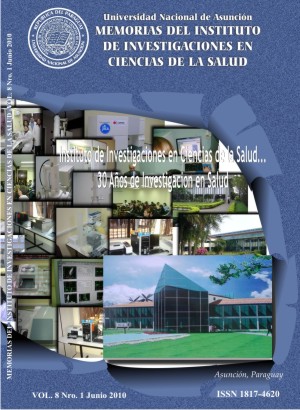Frecuencia y carga viral relativa del virus del papiloma humano de alto riesgo según el diagnóstico citológico en mujeres paraguayas por captura híbrida II
Palabras clave:
Carga viral relativa, virus del papiloma humano de alto riesgo, captura híbrida II, diagnóstico citológico.Resumen
El cáncer de cuello uterino es el tumor maligno más frecuente en mujeres de Latinoamérica y su agente causal es el virus del papiloma humano (HPV). Recientemente en Paraguay incorporamos el método de captura híbrida II (CH II), el cual detecta 13 tipos de HPV de alto riesgo oncogénico (HR-HPV) y proporciona valores relativos de carga viral. El objetivo del estudio fue determinar la carga viral relativa de HR-HPV por CH II según el diagnóstico citológico. Fueron incluidas 566 mujeres (33 + 10 años) atendidas en el Instituto de Investigaciones en Ciencias de la Salud 2006/2009. Fue detectado HR-HPV en 43% de las mujeres (241/566), observándose una alta frecuencia del 23% en mujeres con ausencia de lesión intraepitelial (NSIL). Según el diagnóstico citológico, se evidenció una diferencia altamente significativa entre los valores de carga viral relativa (p<0,0001; Kruskal Wallis), observándose un aumento de carga viral relativa de mujeres con NSIL a mujeres con SIL (68 pg/ml en ausencia de SIL; 710 pg/ml para SIL de bajo grado-LSIL y 474 pg/ml para SIL de alto grado-HSIL). No se observó cambio significativo en la carga viral relativa entre LSIL y HSIL (p=0,60; prueba t de Student). Los resultados sugieren que los valores de carga viral relativa proporcionados por CH II pueden ser considerados como un indicador importante en el manejo de mujeres con sospecha de SIL.
Descargas
Citas
Parkin DM, Bray F, Ferlay J, Pisan P. Global cancer staditics 2002. C A Cancer J Clin 2005 Mar-Apr; 55:74-108.
Lewis, Merle J. Análisis de la Situación del cáncer cervicouterino en América Latina y el Caribe. Organización Panamericana de la Salud/ Organización Mundial de la Salud (OPS/OMS). Washington DC, 2004.
Bosch FX, Lorincz A, Munoz N, Meijer CJ, Shah KV. The causal relation between human papillomavirus and cervical cancer. J Clin Pathol 2002 Apr;55(4):244-65.
Munoz N, Bosch FX, de Sanjose S, Herrero R, Castellsague X, Shah KV, et al. International Agency for Research on Cancer Multicenter Cervical Cancer Study Group. Epidemiologic classification of human papillomavirus types associated with cervical cancer. N Engl J Med 2003 Feb6; 348(6):518-27.
Wright TC Jr, Schiffman M, Solomon D, Cox JT, Garcia F, Goldie S, et al. Interim guidance for the use of human papillomavirus DNA testing as an adjunct to cervical cytology for screening. Obstet Gynecol 2004 Feb; 103(2):304-9.
Dôres GB, Taromaru EK, Bonomi CG, Longatto A Filho, Gilli NP, Matsubara S, et al. HPV infection detected by hybrid capture II: correlation with morphological findings. DST – J bras Doenças Sex Transm 2005 17(4): 255-8.
Carvalho MOO, Almeida RW, Leite FMS. Detection of Human Papillomavirus DNA by the Hybrid Capture Assay. Braz J Infect Dis 2003;7(2):121-5.
Cox JT, Lorincz AT, Schiffman MH. Human papillomavirus testing by hybrid capture appears to be useful in triaging women with a cytologic diagnosis of ASCUS. Am J Obstet Gynecol 1995 172:946-54.
Sun CA, Liu JF, Wu DM, Nieh S, Yu CP, Chu TY. Viral load of high-risk human papillomavirus in cervical squamous intraepithelial lesions. Int J Gynecol Obstet 2002;76:41-7.
Zerbini M, Venturoli S, Cricca M, Gallinella G, De Simone P, Costa S, et al. Distribution and viral load of type specific HPVs in different cervical lesions as detected by PCR-ELISA. J Clin Pathol 2001 May; 54 (5): 377-80.
Sherman ME, Wang SS, Wheeler CM, Rich L, Gravitt PE, Tarone R, et al. Determinants of human papillomavirus load among women with histological cervical intraepithelial neoplasia 3: dominant impact of surrounding low-grade lesions. Cancer Epidemiol Biomarkers Prev 2003 Oct; 12 (10): 1038-44.
Flores R, Papenfuss M, Klimecki WT, Giuliano AR. Cross-sectional analysis of oncogenicHPVviral load and cervical intraepithelial neoplasia. Int J Cancer 2006 Mar 1; 118 (5): 1187-93.
Tulio S, Pereira LA, Neves FB, Piazzetta Pinto A. Association between high-risk human papillomavirus DNA load detected by hybrid capture II and high-grade precursor lesions of cervical cancer in women. J Bras Patol Med Lab 2007 Fev; 43 (1):31-5.
Solomon D, Davey D, Kurman R, Moriaty A, O’Connor D, Prey M, et al. For the Forum Group Members and the Bethesda 2001 Workshop. The 2001 Bethesda System. Terminology for Reporting Results of Cervical Cytology. JAMA 2002; 287:2114-9.
Lorincz AT, Castle PE, Sherman ME, Scott DR, Glass AG, Wacholder S. Viral load of human papillomavirus and risk of CIN 3 or cervical cancer. Lancet 2002 Jul 20; 360 (9328): 228-9.
Lorincz AT, Richart RM. Human papillomavirus DNA testing as an adjunct to cytology in cervical screening programs. Arch Pathol Lab Med 2003 Aug;127 (8): 959-68.
Santos AL, Derchain SF, Martins MR, Sarian LO, Martinez EZ, Syrjänen KJ. Human papillomavirus viral load in predicting high-grade CIN in women with cervical smears showing only atypical squamous cells or low-grade squamous intraepithelial lesion. Sao Paulo Med J 2003 Nov 6; 121 (6): 238-43.
Carvalho MOO, Carestiato FN, Perdigao PH. Human papillomavirus infection in Rio de Janeiro, Brazil: a retrospective study. The Brazilian Journal of Infectious Diseases 2005;9(5):398-404.
Castle PE, Wacholder S, Sherman ME, Lorincz AT, Glass AG, Scott DR. Absolute risk of a subsequent abnormal pap among oncogenic human papillomavirus DNA-positive, cytologically negative women. Cancer 2002 Nov 15;95(10):2145-51.
Morrison H. Human papillomavirus absence predicts normal cervical histopathologic findings with abnormal papanicolaou smears. J Hum Virol 1993;4:283-7.
Ferreccio C, Bratti MC, Sherman ME, Herrero R, Wacholder S, Hildesheim A. A comparison of single combined visual cytologic, and virologic tests as screening strategies in region at high risk of cervical cancer. Cancer Epidemiol Biomarkers Prev 2003 Sep;12(9):815-23.
Hernandez-Hernandez DM, Ornelas-Bernal L, Guido-Jiménez M, Apresa-Garcia T, Alvarado-Cabrero I, Salcedo-Vargas M. Association between high-risk human papillomavirus DNA load and precursor lesions of cervical cancer in Mexican women. Gynecol Oncol 2003 Aug;90(2):310-7.
Gravitt PE, Burk RD, Lorincz A, Herrero R, Hildesheim A, Sherman ME, Bratti MC, Rodriguez AC, Helzlsouer KJ, and Schiffman M. A Comparison between Real-Time Polymerase Chain Reaction and Hybrid Capture 2 for Human Papillomavirus DNA Quantitation1 Cancer Epidemiology, Biomarkers & Prevention 2003; 12:477–84.
Lillo FB, and Uberti-Foppa C. Human papillomavirus viral load: a possible marker for cervical disease in HIV-infected women. J. Antimicrobial Chemother 2006;57:810–14.














